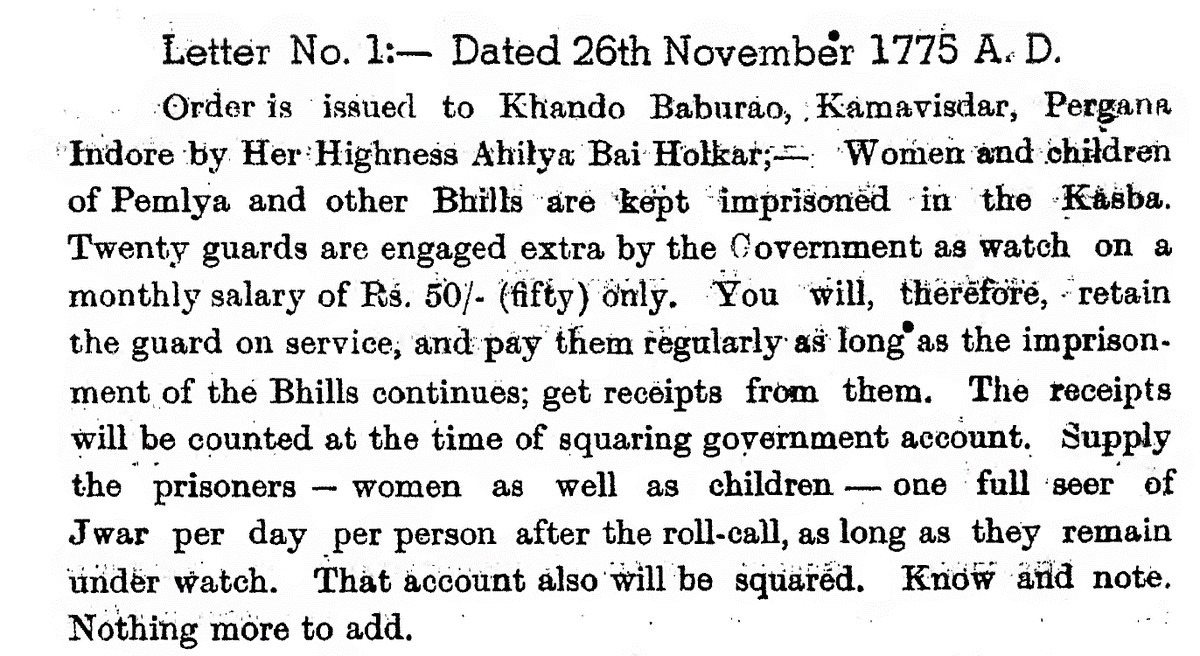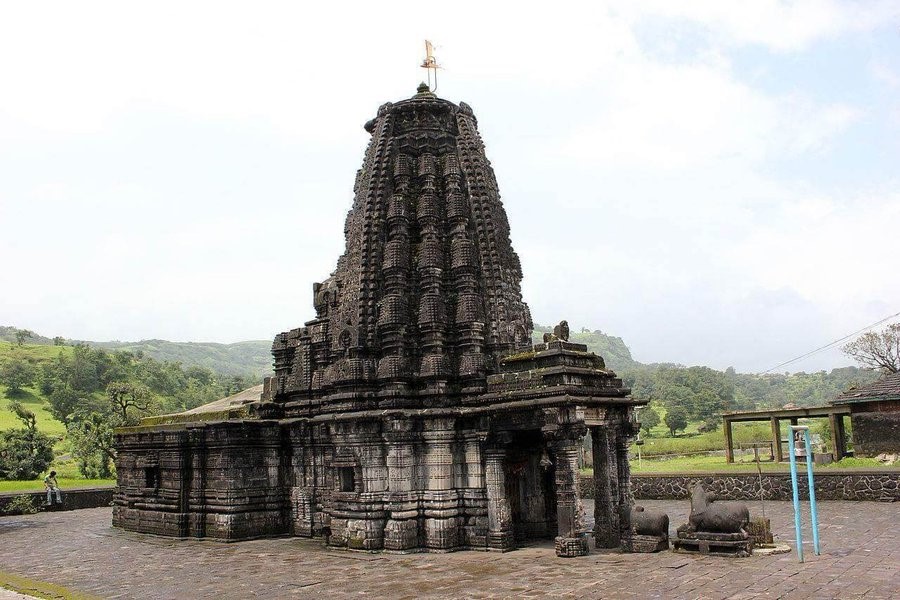Reminiscing the Legacy of Queen of Malwa: Ahilyabai Holkar, the Pride of India
- In History & Culture
- 01:04 PM, Dec 15, 2021
- Bharadwaj Speaks
Ahilyabai Holkar was a widow who became Malwa's greatest queen. Defended our country and personally led armies into battle and never plundered anyone. Developed Malwa into a prosperous kingdom. Rebuilt temples destroyed by Mughals. Built Dharmashalas at Tirthas.
Unfortunately, her memory has been blemished by inaccurate representations in modern popular media. The serial "Punyashlok Ahilyabai" depicts her as ultra-secularist feminazi icon who questions Hindu rituals and Pandits while patronising Sufis. This is far from historical truth!
Ahilyabai was born on May 31 1725 to Patil Mankoji Shinde. She was from Dhangar clan (classified as OBC today). While Dhangars were traditionally into herding, they took up arms and held several military /civil roles in various eras of history (especially during Maratha resurgence).
In 1737, when she was 12, Ahilyabai Holkar was married to Khanderao, son of Subedar Malhar Rao Holkar. By the time she was married, fortunes of Holkar family had already waxed. Malhar Rao was a Subedar of territory comprising 30 Parganas yielding a revenue of at least 7 Lakhs.
In 1741, when Ahilyabai was newly married, her father -in-law Malhar Rao built Indore palace and ordered the kanungo to populate the settlement with a promise of protection to traders. This began rise of Indore from its background as modest trading town Indrapuri to a great city.
While her father and father-in-law were frequently away to lead the northern campaigns of Maratha empire, it was Ahilyabai Holkar who ran the administration of Indore. She had already become extremely popular due to her policy of mercy and justice towards people.
On 24th March 1754, when Ahilyabai was only 29, her husband Khanderao Holkar passed away in the siege of Kumher (Bharatpur) when a cannon accidently hit him. The siege failed. The great Jat Maharaja Suraj Mal even constructed Samadhi for his opponent. Ahilyabai became a widow.
Ahilyabai had given up all desires of life and decided to perform Sati to accompany her husband at his funeral pyre. People requested her not to commit Sati. But she said " he pledged to accompany me life long. Now he has left midway. Hence, it is proper for me to commit Sati"

When she had made up her mind to perform Sati and was not relenting one bit, it was finally her father-in- law Malhar Rao Holkar who made fervent emotional appeals to stop her He said "Daughter, my son left me. If you leave me too, I will be without support. Let me die first"
Malhar Rao Holkar finally burst into tears and fell at the feet of his daughter-in-law Ahilyabai Holkar. This fervent appeal forced Ahilyabai to give up her decision of committing Sati.
After the death of her husband, Ahilyabai Holkar was groomed by Malhar Rao both in military and diplomatic affairs. This letter in 1765 from Malhar Rao addressed to Ahilyabai throws light on the situation. He sends her on a military expedition to Gwalior with big artillery.
This letter clearly shows not only that Ahilyabai was military trained, she was also considered capable enough to run civil and military affairs. This is a fitting testament that a woman from humble origins could run important departments of the state in premodern Hindu India.
When Abdali invaded India again in 1765, Malhar Rao was fighting the Abdali-Rohilla army in Delhi. During the same time, Ahilyabai Holkar captured Gohad fort (near Gwalior). Malhar Rao in his letter instructed her to "manufacture gun balls and balls of smaller size".
While Malhar Rao was embarking on northern campaigns, it was Ahilyabai who secured the rule of Holkars in Madhya Pradesh region. Malhar Rao's letters clearly show it was Ahilyabai who captured Gwalior and secured it for Holkar kingdom. Ahilyabai's strength was her artillery.
Malhar Rao passed away in 1766. Ahilyabai's son Maloji then became Governor. He was distressed at the loss of his grandfather and unprepared. Ahilyabai sent a very hearty and inspirational letter urging her son not to think of past and direct his thoughts to management of state.

Unfortunately, he died within 8 months. Then, rather than adopt an heir, Ahilyabai petitioned the Peshwa to rule the Holkar lands herself. Ahilyabai already had an established record of military and civil competence. She was now the defacto Holkar ruling queen of Maheshwar.
On becoming ruler, Ahilyabai exercised her policy of justice and reconciliation. She pardoned rebel Chandrawat chiefs and granted them 31 villages. But they rebelled again. She crushed them militarily, forced a treaty and punished the rebel chiefs. Complete victory was secured.
The fame of her arms spread far and wide. However, even after crushing the Chandrawats, she chose to stick to her policy of mercy and pardon. Once again, she forgave and reinstated the Chandrawat chief and a dress of honor was given to him. The Chandrawats did not rebel again.

Ahilyabai's reign was famed for justice not only towards her own people but also her rivals. She frequently wrote letters asking about the welfare of women and children of rival chiefs who were imprisoned in jail. She made sure the prisoners received adequate amount of food.

When a farmer collecting taxes from the villages was robbed of all money, the merciful queen Ahilyabai instead paid the money to them from her own expenses instead of punishing them. Such a benevolent gesture is hardly with a parallel in those days of loot, plunder and mayhem.

The name of Ahilyabai had become a byword for honesty and Kindness. While she worked hard to run the affairs of the state, she never burdened people. When a specific year did not witness much rain, she did not tax her farmers even a penny. People saw Rajmata as their own mother.
Personally, Ahilyabai Holkar led an extremely simple and religious life. Her "palace" is shockingly modest and simple. She used to live in a small residence in Maheshwar. She never built anything for herself. Her "throne" was just a simple chair and did not have a single ornament.

Ahilyabai rose at 5 AM every day for her Puja. She then heard the recitation of Puranas and donated to brahmins before consuming breakfast. She forsake non-vegetarian food, onion and garlic. Except during durbar, she never sat on throne. She wore plain white and slept on the floor.

Ahilyabai's greatest contribution to Indian civilization is rebuilding Hindu temples and tirthas that were destroyed during Islamic conquests and rule. Without her, ALL Tirthas would have been in ruins and there wouldn't be any standing temple. Map showing temples built by her-

Ahilyabai visited Somnath and was moved by the sight of destroyed temple with mosque built on top of it. She constructed Somnath Mahadev Mandir opposite the (erstwhile) mosque and installed the Linga there. Many Hindus believe this temple houses the original Somnath Jyotirlinga.
She visited Srisailam which was then in the domain of Nizam. The temple had been destroyed and lying in ruins. She rebuilt temple and constructed Pushkarini. Wherever possible, Ahilyabai honored local tradition and built the temple according to regional style and custom.
The original Omkareshwar temple was destroyed during Tughlaq Invasion. The present temple at Omkareshwar was built by Ahilyabai Holkar. She also presented the silver murti.
During those days of Nizam, The Mallikarjuna temple at Srisailam was destroyed in a very pitiable condition. It is one of the Jyotirlingas Here is the letter from Maratha ambassador requesting the intervention of Ahilyabai Holkar to rebuild the temple and construct repair works.

The Aundha Nagnath Jyotirlinga, destroyed during Aurangzeb's conquests, was rebuilt by Ahilyabai Holkar. The present standing temple was built by her.
After Aurangzeb destroyed the original Vishwanath temple and built Gyanvapi Mosque on top of it, Ahilyabai constructed the current temple of Kashi Vishwanath right next to mosque. It is all thanks to Ahilyabai Holkar that Hindus can still worship at Kashi Vishwanath.

Manikarnika Ghat was destroyed during the Mughal age. The present Manikarnika Ghat with its temples was built by Ahilyabai Holkar.

To the left of manikarnika is the Tarakeshwara temple. The Taraka linga is intalled in this temple. It is believed that Shiva here chanted Taraka mantra in the ear of departed which lead to liberation. The present Tarakeshwara temple was built by Ahilyabai Holkar.

She also built the Kevalagiri (Ahilya) Ghat and constructed Brahmapuri which housed and provided free food and residence for thousands of Brahmins, Sannyasis and pilgrims. Inside Brahmapuri she built Annapurna temple where 24*7 Annadana (even at night) was provided to pilgrims.
The Kushavarta Kund at Triyambakeshvara Jyotirlinga (Nasik) was built by none other than Ahilyabai Holkar.

The Grishneshwara Jyotirlinga temple of Ellora was destroyed by Khiljis. It was rebuilt by Ahilyabai Holkar. Today, most tourista to Ellora caves do not even know of this temple situated less than a kilometer away .

Ahilyabai Holkar repaired the Bhimashankar Jyotirlinga temple and constructed a Garibkhana (alms house) there. It is believed by many devout Hindus that Bhimashankar linga is the original Lingodbhava Murti.

Ahilyabai Holkar also rebuilt the ancient Vishnupada temple of Gaya. It is believed by devout Hindus that this temple houses footprints of Vishnu. After the reconstruction of this temple, Hindus were able to commence their shraddha and Pinda funeral rites in Gaya again.

Ahilyabai was also a great patron of arts and crafts. She promoted weaving and textiles by offering them concessions, advance and security. The famous Maheshwari saree industry owes its origin and growth to her. According to a tradition, the first saree was designed by her.
Ahilyabai Holkar also patronised various scholars of Vedas, Puranas, astronomy, astrology and medicine in her court. Scholars from all over India flocked to her court where they were given due respect and rehabilitation. She personally crowned Vedic scholars and washed their feet.


While the serial depicted Ahilyabai as a secularist who questions Hindu priests and rituals Ahilyabai's own letters show that she styled herself as "Protector of cows and Brahmins".

Ahilyabai stopped capital punishment. She instead took personal oath from prisoners and released them. Many of the prisoners adopted honest life. Indore became a very safe and prosperous city under her rule and people from Bombay, Surat and Pune used to settle here.
Ahilyabai introduced 7/12 scheme when there were droughts. According to this scheme, farmers had to pay no fixed tax but 5/12 only when there were rains and the crop was abundant. Farmers prospered. No trader tax beyond custom. Her subjects weren't afraid to display wealth.
Ahilyabai who built temples, orphanages, residences and irrigation tanks all over India led a modest personal life. She used to live in this small residence in Maheshwar. Never built anything for herself. The Saint Queen used to sleep on floor. Her lips always uttered "Shiva".
All the images are provided by the author. Title image source: Hindi World
















Comments